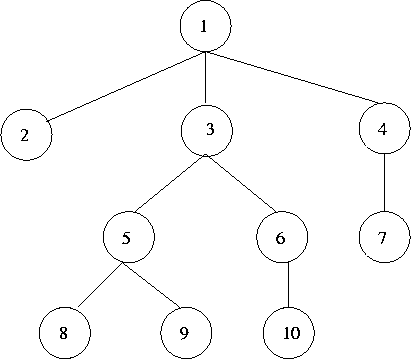


Next: 4.1.3 The Tree ADT
Up: 4.1 Introduction
Previous: 4.1.1 Definitions
-

- If a tree is null, then the empty list is the preorder, inorder, and
postorder listing of T
-

- If T comprises a single node, that node itself is the preorder, inorder,
and
postorder list of T
-

- Otherwise
- 1.
- The preorder listing of T is the root of T, followed by the nodes of
T1 in preorder, . . . , and the nodes of Tk in preorder.
- 2.
- The inorder listing of T is the nodes of T1 in inorder, followed by
the root r, followed by the nodes of T2 in inorder, . . . , and the nodes of
Tk in inorder.
- 3.
- The postorder listing of T is the nodes of T1 in postorder, . . . ,
the nodes of Tk in postorder, all followed by the root r.
-

- Example: see Figure 4.2.
-
-
- Preorder 1,2,3,5,8,9,6,10,4,7
-
- Postorder 2,8,9,5,10,6,3,7,4,1
-
- Inorder 2,1,8,5,9,3,10,6,7,4
-

- Note that the order of appearance of the leaves is the same in all the three
schemes. This is true in general.
Figure 4.2:
Example of a general tree
 |



Next: 4.1.3 The Tree ADT
Up: 4.1 Introduction
Previous: 4.1.1 Definitions
eEL,CSA_Dept,IISc,Bangalore
